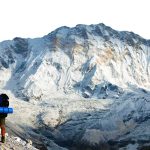A trek to the Annapurna Circuit in March is one of the best decisions you can make, as this month captures the region at its most rewarding state. March signals the start of spring in the Nepal Himalayas. The long and cold winter begins to loosen, the skies open up with crisp clarity, and the valleys slowly warm. Rhododendron forests show their first blossoms, adding gentle color to the lower trails. At the same time, the heavy crowds of April haven’t arrived yet, giving March trekkers a rare mix of solitude and scenic beauty.
Interestingly, the Annapurna Circuit is full of contrasts in March. Higher up, the trail still carries winter snow. But the lower sections feel alive with early spring. In between, trekkers can enjoy stable and mild temperatures that are ideal for long days on foot.
This balance is one reason Radiant Treks conducts many of its successful spring treks in March. Clear mountain views, manageable temperatures and quieter trails create an unforgettable trekking environment.

Covering roughly 160 to 230 km, the Annapurna Circuit trek in March is considered moderately challenging. But trekking in March brings the benefit of favorable early-spring weather. The trail conditions are stable, and the overall atmosphere remains calm, making this adventure suitable for both seasoned trekkers and motivated beginners.
If you are ready to circle the majestic Annapurna Massif — passing Annapurna I, Machhapuchhre, Dhaulagiri and Tilicho Peak — March is a rewarding time to do it. The landscapes rise and fall, eventually leading you to Thorong La Pass, the highest point of the trek.
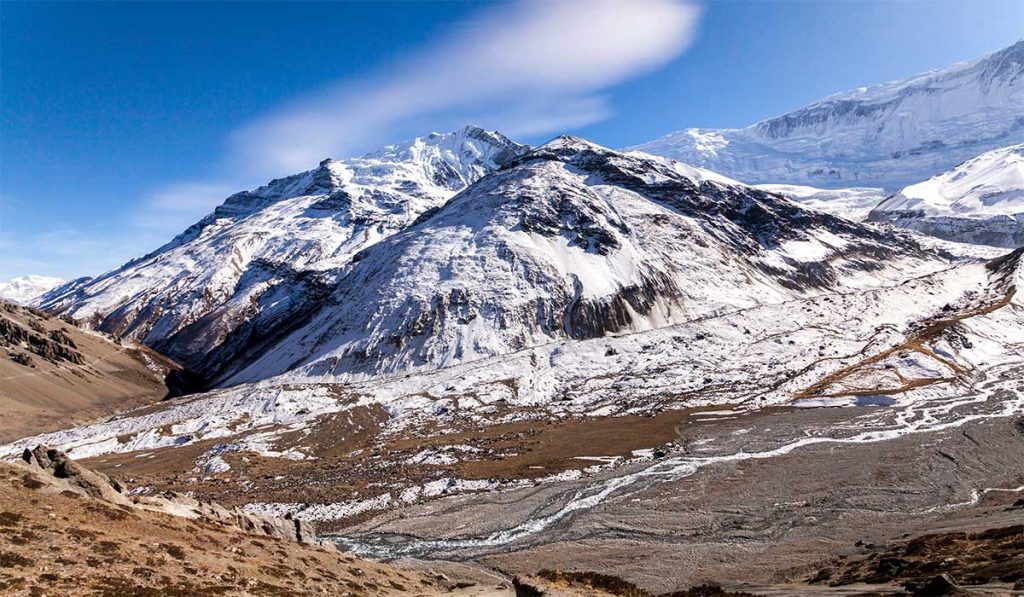
Along the way, you traverse six districts within the Annapurna Conservation Area and experience shifting cultures, climates and landscapes in a single journey. For a smooth and memorable experience, contact Radiant Treks for your March adventure.
Highlights
- March kicks off spring in the Himalayas with clearer skies, blooming rhododendrons and fewer crowds than April
- It is a perfect month for a peaceful trek around the Annapurna Massif
- Expect a mix of winter’s chill up high and spring’s warmth down low, with temperatures at -15°C at Thorong La Pass
- Trails are mostly stable but watch for icy patches early in the month; grab microspikes for that extra grip on slippery spots
- Mornings are crisp and offer some of the best views of peaks like Annapurna II and Gangapurna
- Winds can pick up after noon, especially near the pass, so start your days early
- The trek’s moderate difficulty suits fit beginners — think 6 to 8 hour days, big elevation gains, but milder weather makes it rewarding
- Build stamina with hikes, squats and backpack walks for 4 to 5 weeks before the trek to handle the altitude and long hauls
- Go with a guide — it’s required and helpful for weather checks, pacing and securing lodge spots in March’s unpredictable bits
Why Trek the Annapurna Circuit in March?

March is the first real month of trekking season after winter. It carries the freshness of spring, the crisp air of late winter, and just a hint of snow lingering on the high passes. These conditions make for a uniquely beautiful trek.
Clear Views and Blue Skies
After winter storms settle, the atmosphere clears dramatically. This is one of the best months for unobstructed views of Annapurna II, Annapurna III, Gangapurna, Tilicho Peak, Chulu ranges and even Manaslu on the early trail sections. Mornings, especially, are vibrant and crystal-clear.
Less Crowded Than April
April is the busiest month on the Annapurna Circuit. March, by contrast, is lively but not overwhelming. Lodges have space, dining halls are quieter and trail sections remain relaxed even on popular stretches around Manang.
Spring Begins in Lower Valleys
The first rhododendrons appear around mid-March, along with sprouting terraced fields, warmer air, and longer days. You get a taste of both winter and spring in a single trek.
Good Balance of Temperature and Trail Safety
Compared to January and February, March is noticeably warmer and far safer in terms of snowfall and pass accessibility. Thorong La is open almost every day unless an unusual storm passes through.
March Compared to Other Months
April vs March: March has fewer crowds; April has brighter forests and milder nights.
May vs March: March is cooler and clearer; May gets hotter with more haze.
Autumn vs March: Autumn is more stable but March gives spring charm. There are fewer trekkers and the atmosphere is softer.
March hits the sweet spot for trekkers who love clear skies, comfortable temperatures and peaceful trails.
What about the March weather on the Annapurna Circuit?

March weather and temperature vary sharply with altitude, so understanding the full picture helps you plan properly.
Temperatures can swing wildly as you climb, thanks to the thinning air and changing landscapes, from lush valleys to stark high passes. Expect a mix of sunny warmth and biting cold, especially as you gain elevation. Layering is your best friend here to handle the shifts.
Lower Trail: From the sections beginning from Dharapani (1,860m) to Chame (2,670m), days typically run from 10°C to 18°C, sometimes pushing up to 20°C on sunnier stretches. This is pretty pleasant for walking. Likewise, nights cool off to 2°C to 7°C, so a light jacket or fleece should suffice during the day, but you’ll want something warmer for evenings.
Mid Elevation: Days chill out to 3°C to 10°C from Pisang (3,300m) to Manang (3,540m). The crisp air feels refreshing but demands more insulation of your body. Nights drop sharply and temperatures often reach -5°C to -8°C. A quality down sleeping bag with a sub-zero rating will make all the difference. And don’t forget to acclimatize to avoid altitude issues.
High Elevation: From Yak Kharka (4,020m) to Thorong La Pass (5,416m), it gets intense. The days might hover between -5°C and 4°C, but with the sun out, it can feel a tad milder. Similarly, nights plunge to -10°C to -15°C or lower. And wind chill amplifies that, sometimes making it feel like -20°C or lower. Heavy layers, insulated boots and windproof gear are essential.
Does March offer good visibility?

Yes, March is known for offering great clarity. One of March’s big perks is the crisp and clear air. As the post-winter haze has cleared out, March gives you those epic panoramic views that make the Circuit legendary. It’s not perfect every day, but the odds are in your favor for stunning sights.
- March mornings are often bright, blue and very sharp. There is minimal cloud in the sky. Thus, you can see unobstructed views of peaks like Annapurna II or Gangapurna.
- Afternoons in March can get a bit cloudy or hazy as warmth builds. But this is not much of an obstacle, as it does not block everything most of the time.
- Evenings frequently reward you with vibrant sunsets painting the Annapurna ranges in oranges and pinks in March. This time is perfect for those reflective moments at camp.
With over 11 hours of daylight, you have ample time to cover ground without feeling rushed. Also, the stable weather means fewer disruptions from fog or storms as compared to the monsoon season.
Can the March wind affect my Annapurna Circuit trek?
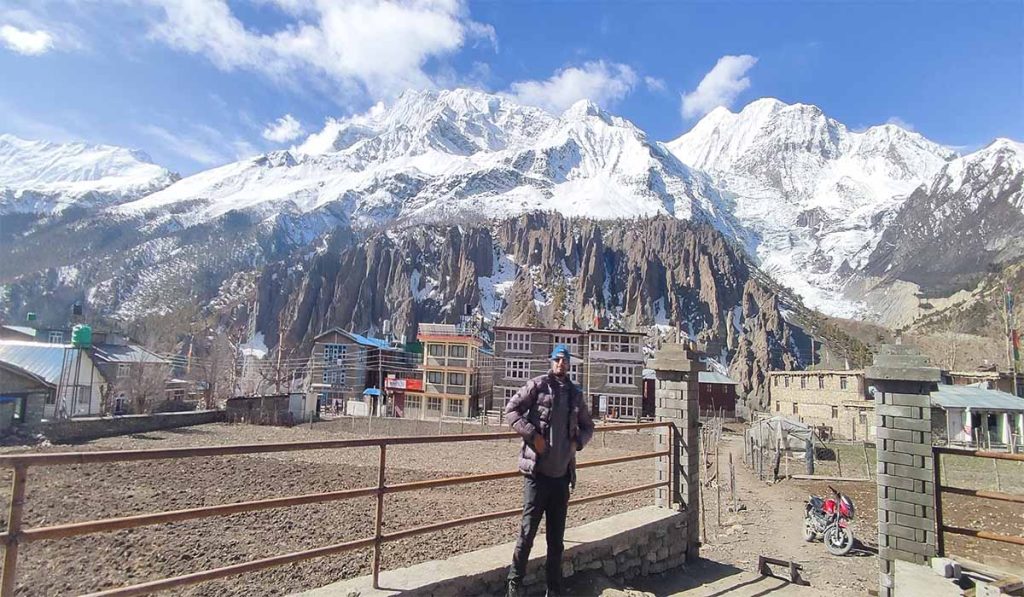
Winds on the Circuit are tricky and might make an impact on your March trek. They turn strong during the afternoon as compared to the morning. They are not constant in March, but you should make plans with consideration of the wind. This is necessary for a comfortable trek, especially at higher spots where the winds bite harder.
After midday, the winds really start getting stronger, especially up in the higher reaches of Manang and around Thorong Phedi. They move through the passes and add to the chill. That’s why most trekkers begin the hike at dawn. This is done to beat the winds and cross Thorong La before the winds turn fierce. Furthermore, this idea reduces your exposure to dust, cold blasts and fatigue.
If you are sensitive to wind, a buff or scarf for your face helps. But always check local updates since patterns can shift with any incoming weather systems.
How difficult is the Annapurna Circuit trek in March?
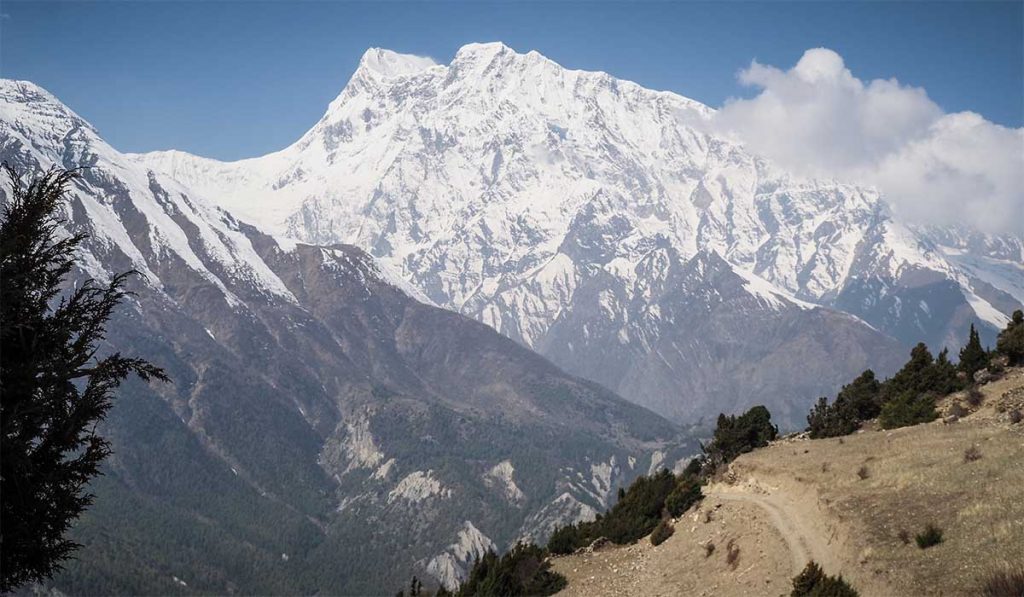
The difficulty level of the March Annapurna Circuit trek can be labelled as moderate. It is challenging enough to feel rewarding but not as brutal as winter treks with heavy snow. It’s a 160 to 230 km loop with daily hikes of 6 to 8 hours. It also includes steep ascents like the 5,416m Thorong La Pass. Altitude sickness can hit at this elevation if you don’t acclimatize.
Fitness-wise, if you can handle 15 to 20 km days with elevation gains, then you are ready for this trek. Therefore, it is ideal for moderately fit people or prepared beginners.
What eases it up: Stable trails with melting snow, fewer storms, mild lower-elevation temperatures (10 to 18°C days), fully open teahouses for hot meals and beds and more than 11 hours of daylight to pace yourself. Likewise, crowds are thinner than in peak months and spring flowers add motivation.
The tough aspects: Freezing nights above 3,500m (-10°C or lower), occasional icy patches near the Thorong La Pass (micro-spikes recommended for early March trek) and afternoon winds that sap energy up high can be challenging. Start the trek early every day to dodge them.
How should I physically prepare for the Annapurna Circuit trek in March?

Build stamina over speed to get your body ready for the March Annapurna Circuit trek. Think of making a consistent effort for those long days crossing Thorong La. This can begin at least 4 to 5 weeks in advance of the beginning of the trek. You can start with a simple routine.
- Exercise like hitting steep inclines, carrying a 10 to 15 kg backpack and mimicking trail load, helps a lot.
- Beef up your legs with squats (3 sets of 15), stair climb, and weekend hikes on hilly terrain.
- Boost endurance by brisk walking or jogging 5 to 10 km daily, ramping up to 20km.
- Practice deep-breathing exercises every morning. You can inhale for 4 counts, hold 4, and exhale 4 as a way to prepare lungs for thin air above 3,500 meters.
- Rest one day a week to avoid burnout.
If you incorporate the aforementioned activities in your exercise regimen, you will handle 6 to 8-hour days with ease.
What should I include in my March Annapurna Circuit trek packing list?

March is honestly one of the sweetest months that features blooming rhododendrons and blue skies. And the snow is mostly gone except maybe a patch over Thorong La. Days are warm, nights still are cold, so layers are your best friend. Below is a basic packing list for this trek of the Annapurna Circuit in March.
Clothing
- 2 to 3 merino base layers (top and bottom)
- Fleece or light puffy and proper down jacket for evenings and the Thorong La Pass
- Good hardshell jacket and rain pants (March can still throw a surprise of snow and rain)
- Warm hat, buff, thin and thick gloves, 4 to 5 pairs of wool socks
Footwear
- Already broken-in waterproof boots (ankle support is non-negotiable)
- Comfy sandals or Crocs for teahouse evenings
- Gaiters and microspikes (cheaper alternative if you need to walk in the icy pass)
Gear
- 40 to 50L pack (you’ll carry yourself or give to a porter)
- Sleeping bag comfort -10°C (teahouses have blankets but they are thin)
- Trekking poles (save your knees), headlamp, power bank
Other must-haves
- Sunglasses, high SPF sunscreen and lip balm
- Water purification tablets
- Basic medicines, as well as Diamox, blister kit, diarrhea tabs
- Snacks
- ACAP permit, passport photos, cash (no ATMs after Chame)
Is accommodation accessible in March on the Annapurna Circuit?
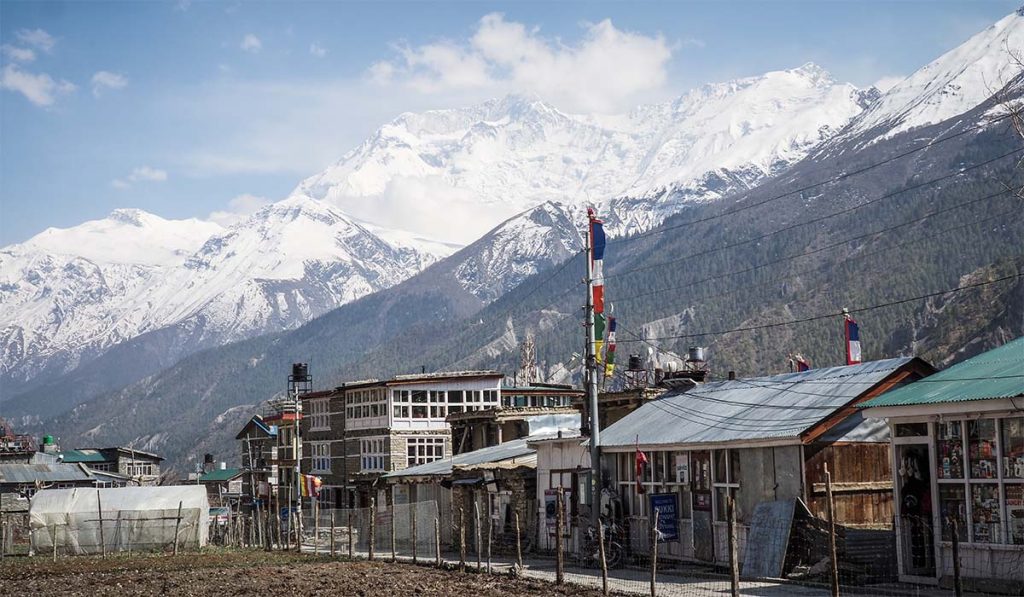
Yes, it is easily available as March is one of the best months for walking in without pre-booking and still getting a room.
Almost every teahouse is open by early March. In fact, they start firing up the stoves in late February. But the April rush hasn’t arrived yet on the Annapurna Circuit. Even popular stops like Upper Pisang, Yak Kharka and Thorong Phedi usually have spare beds.
High Camp can fill on busy pass days, but if you reach by late afternoon, then you are golden. Large groups, however, might get stuck, and thus booking is necessary for them.
Rooms are simple (twin beds, plywood walls, shared toilet), but dining rooms are warm in full swing with yak-dung stoves in the evening. It is pure bliss when the temperature is −8°C outside.
Hot gas or solar showers pretty much everywhere up to Manang and you can avail that service after paying an extra fee. However, you will find bucket water above that.
Wi-Fi exists in most places now, but you need to pay per device.
Food and water on the Annapurna Circuit in March — will I be able to eat well?

You will be able to eat nutritious and filling meals every day on a budget during your March Annapurna Circuit trek. March is perfect because the teahouses are open and the kitchens are actually cooking fresh food. You will get to eat dal bhat twice a day and never get bored with it. It comes hot, with unlimited refills in most places. And it is the smartest thing on the menu — rice, dal, veggie curry, spinach or whatever greens they have, and spicy pickle.
Other food options on the menu are:
- Thukpa or noodle soups (perfect when it’s freezing)
- Fried rice, chow mein, pasta, spring rolls
- Roasted potatoes, pizza (decent in Manang)
- Pancakes, apple pie in Pisang and Braga
- Tibetan bread for breakfast
- Tea, ginger-lemon-honey, hot lemon, milk tea — all unlimited and cheap
- Higher up (Yak Kharka, Thorong Phedi and High Camp), the menu shrinks and prices increase, but you will still get fed properly. No one goes hungry.
In the case of drinking water, bring a reusable bottle with a capacity of 1 to 2 liters. Do not buy plastic water bottles. They are expensive and pollute the pristine mountain environment.
Some options for drinking water during the Annapurna Circuit trek in March include:
- Fill from lodge taps and treat with tablets/drops
- Buy safe water in teahouses
- Safe drinking water stations run by ACAP
What is the itinerary for the March trek of the Annapurna Circuit?

You can opt for the 13-day-long trek of the Annapurna Circuit in March. If you want to include Tilicho Lake in your itinerary, then you may join the trek of 16 days. Radiant Treks has both the trek packages on offer for the March trek. Nonetheless, the general outline of the itinerary is presented below:
- Day 1: Arrival in Kathmandu
- Day 2: Preparation for Trek in Kathmandu
- Day 3: Drive from Kathmandu to Dharapani
- Day 4: Trek to Chame from Dharapani
- Day 5: Trek to Pisang from Chame
- Day 6: Trek to Manang from Pisang
- Day 7: Acclimatization Day in Manang
- Day 8: Trek to Yak Kharka from Manang
- Day 9: Trek to Thorong Phedi from Yak Kharka
- Day 10: Trek from Throng Phedi to Muktinath via Thorong La Pass
- Day 11: Visit Muktinath Temple in the Early Morning and Drive to Pokhara
- Day 12: Pokhara to Kathmandu
- Day 13: Departure from Kathmandu
The itinerary will require you to trek to Siri Kharka on the eighth day and then to Tilicho Base Camp on the ninth day, if you choose the journey of 16 days. In the following two days, you will hike to Tilicho Lake and back to Siri Kharka and Yak Kharka. The itinerary of the remaining days is the same as that of the 13-day trek. You can choose the trek package based on your preferences.
How does the Annapurna Circuit trek route transition in March?

The route of the Annapurna Circuit trek in March makes you traverse every Himalayan ecosystem — from lush subtropical gorges to barren high passes and trans-Himalayan desert. This diversity, condensed into less than two weeks of walking, makes this route one of the best in the world.
Lower Section
In March, the lower section of the trail (1,860 to 2,670 meters) welcomes spring with pleasant daytime temperatures, crystal-clear skies, and minimal rainfall. Lush pine forests explode with blooming rhododendrons in vivid reds and pinks. Waterfalls run full and trails remain dry and inviting. Chame offers pristine views of Annapurna II and Manaslu, rewarded by soothing hot springs.
Mid Section
The environment shifts dramatically between 2,700 and 3,540 meters. Spring arrives dramatically in this area. It means pine forests vanish and are replaced by open juniper ridges and dry alpine meadows. Rhododendrons burst into full crimson and pink bloom. While the clarity remains a constant thing, Manang features prayer flags snapping in the wind, fresh green shoots in barley fields and snow peaks glowing under perfect sunshine.
Path to Tilicho Lake
You need to ascend to 4,919 meters if you choose to add Tilicho Lake to your itinerary. And March delivers stability for the Tilicho detour. Trails are mostly dry with occasional snow patches, and the landslide zones are safer. The lake is still snow-covered in March. It transforms the lake into a vast and blinding-white expanse locked between gigantic ice walls. Fewer trekkers on the route mean you often have this landscape almost to yourself.
Thorong La Approach and Crossing
As you trek between 4,000 and 5,416 meters, you feel that March is just the right time for this trek. This spring month is prime time for crossing the Thorong La Pass, among other things. Stable weather, deep blue skies and crisp and cold air make every view razor-sharp. Trails are mostly dry with only patchy snow. The 360° panorama from the 5,416 meters is often clear, with Annapurna and Gangapurna peaks glowing in golden morning light. Descent to Muktinath feels like stepping into spring — warmer air, first green shoots and the smell of apple wood smoke.
Do I need a guide for the Annapurna Circuit trek in March?
It is a wise decision to hire a guide for the March Annapurna Circuit trek, as all international trekkers must trek with a licensed guide. In fact, guides are helpful throughout the trek. They spot lingering icy paths of March, track weather shifts, evaluate Thorong La status in March, maintain a steady pace to avoid altitude sickness and secure spots in busy lodges.
How do I obtain a permit for the March Annapurna Circuit trek?

To obtain the trek permit for trekking the Annapurna Circuit in March, you have to process through a registered company. If you choose to trek with Radiant Treks, then it handles your paperwork and obtains the permit needed for the Annapurna Circuit trek in March. You need the Annapurna Conservation Area Permit to be able to trek in this region. Whether you trek in March and other times of the year, the process is the same.
What safety tips should I follow for the March Annapurna trek?
Trekking the Annapurna Circuit in March demands preparations from the trekkers to deal with changing weather and high altitudes. Prioritize your well-being with these practical pointers to stay safe and enjoy the journey.
- Spend time adjusting in Manang, hike up during the day but sleep lower, hydrate constantly and head down if you feel off as a precaution against altitude sickness.
- Start your trek bright and early—those afternoon winds can whip up fiercely around the pass, turning the hike into a real slog.
- Be cautious on icy paths and equip yourself with trekking poles and crampons for grip on slippery and shadowed areas.
- Invest in a quality sleeping bag to maintain warmth in freezing temperatures at higher elevations of the trail.
- Protect your gadgets as batteries die fast, even in the March cold. Keep them close to your body overnight.
- While days are often clear, surprises like storms can hit in March. So, chat with locals, guides or lodge staff for the latest information.
You may also like:





